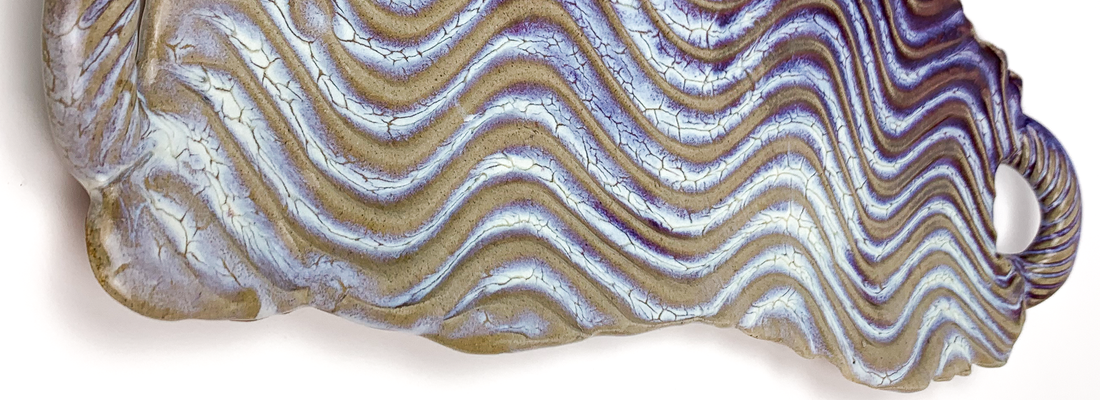
clay techniques: surface
Share
Ceramic pieces come in all kinds of colours and finishes. If you've ever wondered, "how do artists get clay to look like that?", read on to learn about surface treatment techniques for clay.
This post is an excerpt from pondercraft.ca, CCBC's educational website.
Crystalline Glazing: A speciality glaze that encourages visible crystalline growth in the glaze during the firing process. Crystals inhabit many glazes but are typically too small or invisible to see. The crystals are made visible when the firing environment allows them to grow large enough. This means the glaze must remain molten for an extended period, fired at a hotter temperature for a longer duration (1140C/2084°F), and has a chemically high percentage of zinc, titanium or lithium. The crystals form when the kiln is cooling and therefore requires great skill to precisely achieve the necessary temperatures. Because crystalline glazes are quite runny, the pot’s base typically has to be ground and polished after it's been fired.

Embossing/De-embossing: The process where textures and images are either raised or imprinted into the clay, which is then baked in the oven, fixing the design in the material. Some tools include rubber stamps, textured plates and sandpaper.

Glazing: Earthenware ceramics are glazed for both decorative and practical reasons – the glaze works to seal up its pores. Earthenware typically uses two types of glazes, either tin, a white finish, or lead, either clear or cream. Lead glazes are less common as they often are avoided for health concerns, especially when intended for food products. Earthenware’s low firing temperature allows for a wide range of glaze colours through the addition of metal oxides such as copper, iron or cobalt. The glaze used on hard-paste porcelain is solely for decorative purposes, as it is a non-porous material.

Raku Firing: Raku is a traditional type of Japanese pottery used for tea ceremonies. However, the term Raku has since taken on some Western modifications. Artists enjoy Raku for its unpredictability and vibrant colours. The pot is heated at an extremely high temperature, then rapidly cooled. It is this rapid cooling, by water, air or a combustible material, which stops the chemical reaction of the glaze, fixing the vibrant colours and patterns. Western artists have experimented by applying horsehair, feathers and sugar upon removal from the kiln, burning organic patterns onto the pot’s surface, similar to salt firing. Due to the extreme thermal shock involved, stoneware is typically the material used with Western Raku.

Salt Glazing/Firing: When salt or soda (sodium chloride) is added to the kiln during high-temperature firing to produce a pattern. The salt vaporizes and combines with the silica in the clay surface, forming an extremely hard sodium-silicate glaze. This technique gives the clay a glossy, translucent look with an orange-peel-like texture. Salt glazing is specific to Stoneware as it requires its durability and tolerance for high-temperatures to cultivate the desired effect. This glazing technique creates a finish that is food safe.
Learn more about clay and other craft mediums at ponder craft and design, CCBC's educational website.
cover image: "Purple Waves" Tray #1 - Vincent Massey
in-text: Teapot - Fredi Rahn, Ceramic Boot #3 Cowboy - Charmian Nimmo, Raku Sculpture - Bev Ellis, Garlic Keeper - Sandra Ramos
